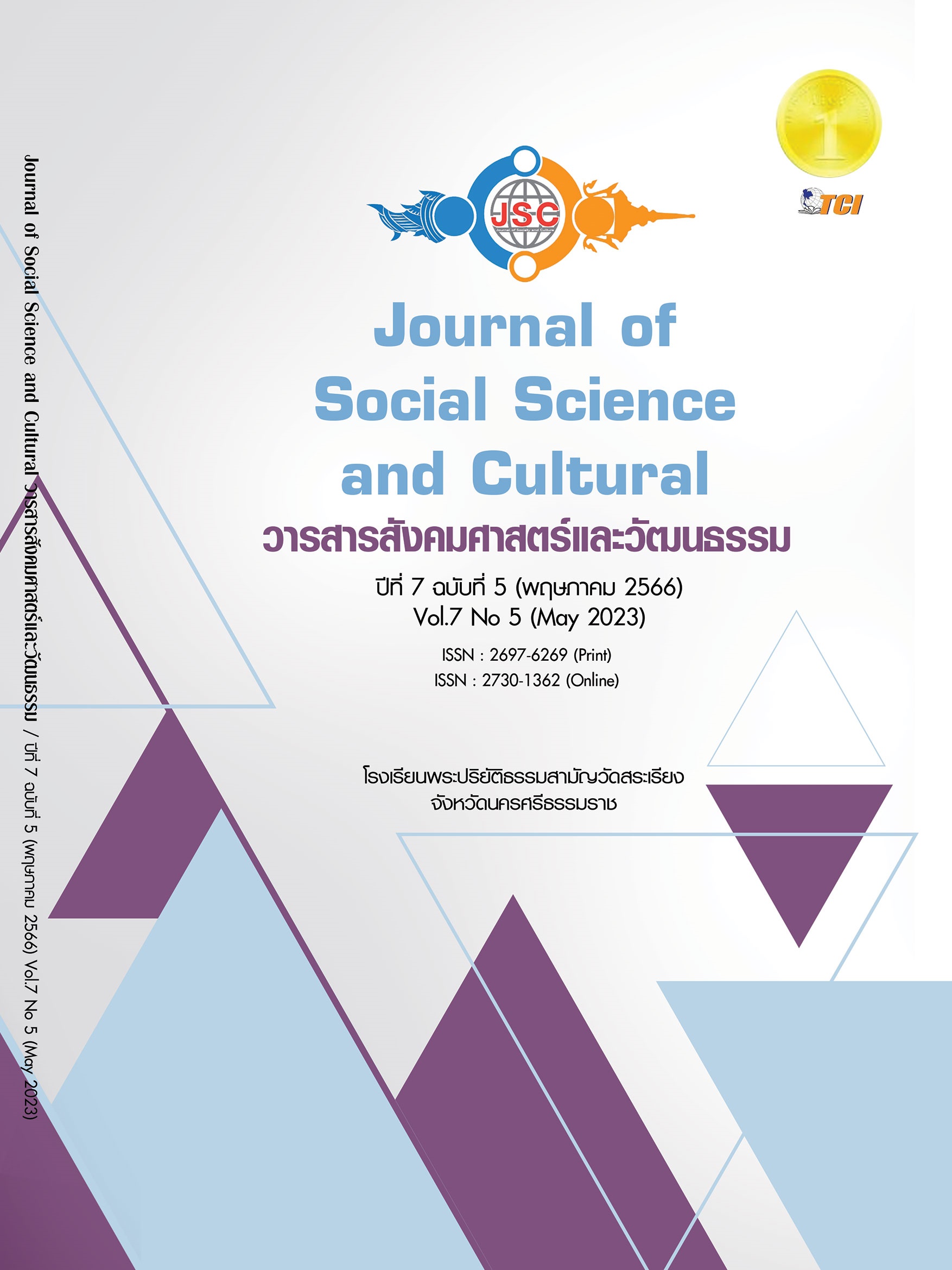THAI GOVERNMENT’S ECONOMIC POLICY COMMUNICATION VIA THE PUBLIC RELATIONS DEPARTMENT’S AFFLIATED
Main Article Content
Abstract
The purposes of this dissertation were to 1) study the current issue of disseminating government economic policies, 2) study the process of disseminating government economic policies, 3) study communication strategies for sharing government economic policies. This qualitative dissertation interviews 20 key informants: (1) two policymaker communication experts from the Public Relations Department; (2) three media executives from the same department; (3) seven social online communication employees from the Department of Public Relations' network; and (4) eight representatives of the Department of Public Relations' audiences. The research tools were structured in-depth interviews, data collection with in-depth interviews and descriptive data analysis. The study's findings revealed that; 1) The current issues: Organizational structure by traditional media by using Facebook to support one more channel of work that makes operators have more workload than assigned tasks. 2) Communication Process: receiving policies from the Cabinet government spokesperson team. Issues are managed by meetings at the Information Operations Center for public relations, set communication strategy then publish the policy using content analyzed from the meeting and evaluate the results of dissemination Summarize opinions on the policy and report to the Cabinet. 3) Communication Strategies: reproducing policy strengths to expand results, clarify and understand each point and reflect weaknesses back to responsible agencies to solve problems. From the study, it was found that communication development guidelines consisted of 1) Coordinate joint policy information between the Public Relations Department and the government in transmitting information systematically. 2) Provide a person responsible for communicating through specific online media channels to use technology to its full potential. And 3) Restructure the organization by clearly assigning responsible persons for online media work.
Article Details
References
กรมประชาสัมพันธ์. (2563). แผนพัฒนาดิจิทัล กรมประชาสัมพันธ์ พ.ศ.2563-2565. เรียกใช้เมื่อ 2 กุมภาพันธ์ 2566 จาก https://www.prd.go.th/th/content/page/index/id/39
จิตตินันทน์ ตั้งประเสริฐ. (2563). นโยบาย การบริหารจัดการ และการใช้สื่อในการสื่อสารเพื่อการประชาสัมพันธ์ ของกรมประชาสัมพันธ์ในบริบทประเทศไทย 4.0. กรุงเทพมหานคร: โรงพิมพ์มหาวิทยาลัยธุรกิจบัณฑิตย์.
ธนาคารแห่งประเทศไทย. (2564). รายงานประจำปี 2564. กรุงเทพมหานคร: ศูนย์การเรียนรู้ธนาคารแห่งประเทศไทย.
นัชชา เกิดอินทร์ และคณะ. (2564). มาตรการการเยียวยาของรัฐต่อผู้ที่ได้รับผลกระทบจากการแพร่ระบาดของการติดเชื้อไวรัสโคโรนา 2019. Journal of Roi Kaensarn Academi, 6 (11), 259-272.
ประเวศน์ มหารัตน์สกุล. (2555). การบริหารค่าจ้างเงินเดือน. กรุงเทพมหานคร: ปัญญาชน.
ประวิทย์ วรธมโม. (2563). การกำหนดนโยบายสาธารณะของรัฐบาลไทย. วารสารมหาจุฬานาครทรรศน์, 8(3), 29-43.
ปรัชญา เปี่ยมการุณ. (2562). ภูมิทัศน์สื่อ ภายใต้บริบทการสื่อสารการท่องเที่ยว. วารสารวิชาการนวัตกรรมสื่อสารสังคม, 7 (1), 113-118.
ปาริชาติ สถาปิตานนท์. (2551). การสื่อสารประเด็นสาธารณะและการเปลี่ยนแปลงในสังคมไทย. กรุงเทพมหานคร: สำนักพิมพ์แห่งจุฬาลงกรณ์มหาวิทยาลัย.
พีระ จิรโสภณ และ คณะ. (2559). ความรู้เท่าทันการสื่อสารยุคดิจิทัลกับบทบาทในการกำหนดแนวทางการปฏิรูปการสื่อสารในสังคมไทย. กรุงเทพมหานคร: โรงพิมพ์มหาวิทยาลัยธุรกิจบัณฑิตย์.
สัญญา สกุลเคณาภูมิ. (2564). กรอบแนวคิดการวิเคราะห์นโยบายสาธารณะฐานคติทางรัฐศาสตร์. วารสารการจัดการภาครัฐและภาคเอกชน, 28(2), 43-68.
สุรพงษ์ โสธนะเสถียร. (2563ก). การบริหารจัดการข้ามสื่อ:จากสื่อมวลชนไปสู่สื่อออนไลน์. วารสารอิเล็กทรอนิกส์การเรียนรู้ทางไกลเชิงนวัตกรรม, 10(2), 1-23.
สุรพงษ์ โสธนะเสถียร. (2563ข). ทฤษฎีการสื่อสาร. (พิมพ์ครั้งที่4). กรุงเทพมหานคร: โรงพิมพ์มหาวิทยาลัยธรรมศาสตร์.
สุรพงษ์ โสธนะเสถียร และสุภาภรณ์ ศรีดี. (2562). หลักและทฤษฎีการสื่อสารทางการเมืองและการปกครองท้องถิ่นขั้นสูง. นนทบุรี: โรงพิมพ์มหาวิทยาลัยสุโขทัยธรรมาธิราช.
อภิชัจ พุกสวัสดิ์. (2558). การพัฒนานวัตกรรมการประชาสัมพันธ์เชิงกลยุทธ์ผ่านการสื่อสารเครือข่ายสังคมออนไลน์ขององค์กรธุรกิจเอกชนในประเทศไทย. วารสารการประชาสัมพันธ์และการโฆษณา, 9(2), 17-37.
อัจฉรา ศรีพันธ์. (2562). โฉมหน้าใหม่ของสื่อสารพัฒนาการการผลักดันให้เกิดการผลิตองค์ความรู้และงานวิจัยด้าน “สื่อสารพัฒนาการ”. วารสารศาสตร์ฉบับ “โฉมหน้าใหม่ของสื่อสารพัฒนาการ”, 12 (2),1-3.
Amri Dunan. (2019). Komunikasi Virtual Game Online Defence Of the Ancient-Dota 2 Pada Komunitas Razer Gaming Depok Virtual Communication in the Defence of the Ancient-Dota 2 Online Game at . Masyarakat Telematika Dan Informasi: Jurnal Penelitian Teknologi Informasi dan Komunikasi, 10(2), 28-36.
Buhmann et al. (2019). Do no Harm and do More Good too: Connecting the SDGs with Business and Human Rights and Political CSR Theory. Corporate Governance: The international journal of , 19(3), 389-403.
Howlett, M., et al. (2017). Understanding co-production as a policy tool: Integrating new public governance and comparative policy theory. Journal of Comparative Policy Analysis: Research , 19(5), 487-501.
Kotler, P. et al. (2017). Marketing For Competitiveness: Asia To The World - In The Age Of Digital Consumers. Singapore: World Scientific.
Orphanides, A. (2019). Monetary Policy Strategy and its Communication. In Proceedings of the 2019 Jackson Hole Economic Policy Symposium. Challenges for Monetary Policy.
Robert K .Logan. (2010). Understanding new media: Extending Marshall McLuhan. New York: Peter Lang Inc., International Academic.
TFW Agency. (2021). จำนวนผู้ใช้งาน Social Media ในประเทศไทย. เรียกใช้เมื่อ 2 กุมภาพันธ์ 2566 จาก https://www.twfdigital.com/blog/2021/02/facebook-instagram-youtube-twitter-users-thailand-2021/


